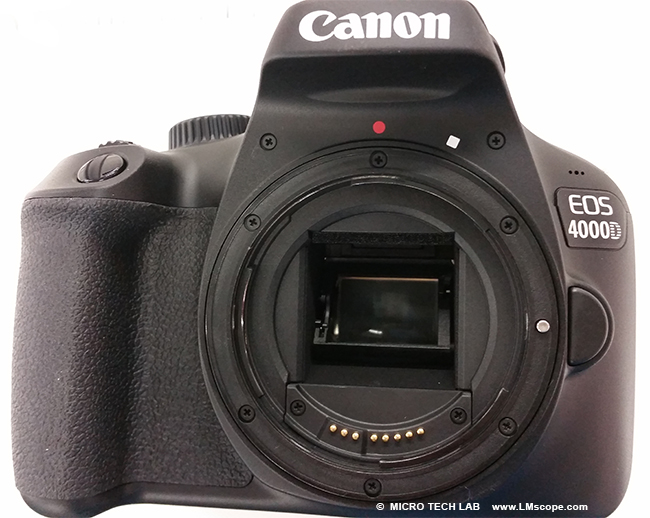

Canon EOS 4000D: How does this no-frills, entry-level camera perform in microscopy?
The EOS 4000D is Canon’s latest stripped-back entry-level DSLR, available at a super-low price of around EUR 270 (body only, no lens). In our review, we focused on the suitability of the EOS 4000D for use with a microscope. As we will see, the features that are important when it comes to the specific needs of microscopy are frequently different from those required for standard photography applications.

The EOS 4000D has an APS-C format sensor with a resolution of 18 megapixels. ISO sensitivity can be set between 100 and 12,800, which places the camera in the mid-range. For microscopy applications, the camera body is attached directly to the microscope via the LM microscope adapter. As a rule, high-quality laboratory and research microscopes have a dedicated photo tube that is designed for attaching cameras. At 485 grams, the camera body of the EOS 4000D weighs the same as that of the 1300D and is thus also very well suited for mounting to an eyepiece tube. With the 4000D attached to the photo tube of a stereomicroscope in combination with our LM widefield adapter, we took this colourful picture of a thistle:

The image above shows that the screen doesn’t tilt or swivel.
For scientific imaging – as is common practice in a photographer’s studio – the camera is controlled remotely from the computer. The Canon EOS Utility software, which is included for free with the camera, is a great tool for this. The images captured can be saved directly to the PC. The EOS 4000D also has built-in WiFi connectivity, which enables remote camera control from a mobile device (e.g. tablet or smartphone) using Canon’s free Camera Connect app, and an HDMI interface for delivering Full HD content to TVs or larger monitors.
In a bid to keep the price of the EOS 4000D down, Canon cut down some of the camera’s features – luckily, these are not very relevant when it comes to photomicrography:
- Plastic lens mount: The lens mount of the EOS 4000D is made of plastic rather than metal – something that hasn’t been seen in years. As the camera is mounted to the microscope and is unlikely to be removed very often, the lens mount won’t be subjected to a lot of stress, and therefore this potential weak spot is irrelevant for us
- Autofocus: As the micrometer screw is used to focus the image when taking pictures through the microscope, the camera’s autofocus is not used at all. Therefore, the 4000D’s slow autofocus for Live View and movies is not a big issue for us.
- Continuous shooting: At three frames per second, the EOS 4000D’s continuous shooting performance is pretty minimal. Continuous shooting is an important feature in many applications, but for photomicrography, a shooting rate of 3fps in full resolution is perfectly adequate.
- On/off switch/mode dial: The EOS 4000D has also done away with a dedicated on/off switch – instead, there’s an “off” setting on the mode dial, which is very easy to use.

- Sensor resolution: The relatively modest pixel count of 18 MP is perfectly adequate for most applications, since in photomicrography, the quality of the microscope/the microscope lenses is more important than the resolution of the camera sensor.
- Fixed screen: A screen with tilt and swivel capabilities is generally a highly useful feature. However, the screen is not used very much when the camera is operated in a stationary position with Canon’s refined EOS Utility software, and therefore, the fact that that the screen of the 4000D doesn’t tilt or swivel and also its small size (display diagonal of 6.8 cm) is not a major issue.
The camera body is made from polycarbonate (plastic) and partially finished with rubber. However, since the camera – unlike when used for outdoor applications – is not exposed to external forces and not subjected to much stress when operated in a stationary setting, this is also not a really big deal for us.
The EOS 4000D comes with the same battery as the EOS 1300D. To save battery life, modern cameras usually have an “auto power off” function. Luckily, this can be disabled through the menu of the EOS 4000D, because it would be extremely annoying (for example during continuous shooting) if the camera were to power down automatically after a certain amount of time (max. 30 minutes). For cameras being used in stationary mode on a microscope, we generally recommend an AC adapter that provides a constant supply of power to the camera.
Conclusion: The Canon EOS 4000D is a basic camera with a great price/performance ratio. The image quality it delivers is adequate for many standard applications in microscopy. In addition, it can be controlled remotely from the PC/Mac and from a smartphone/tablet with the Canon Camera Connect app.